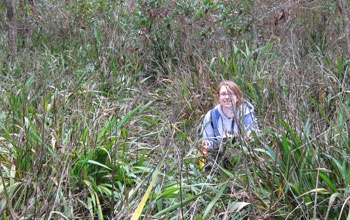
Researcher Kristin Powell amid the invasive plant cerulean flax lily in central Florida.
Credit: Kristin Powell
Download the high-resolution JPG version of the image. (954 KB)
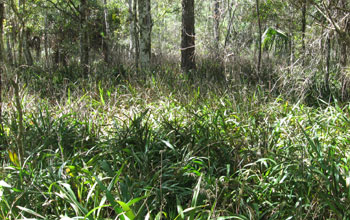
Cerulean flax lily on-the-march through Highlands Hammock State Park in Florida.
Credit: Kristin Powell
| Download the high-resolution JPG version of the image. (1.3 MB) |
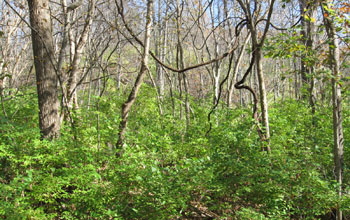
Stand of the invasive plant Amur honeysuckle at the Tyson Research Center in Missouri.
Credit: Kristin Powell
Download the high-resolution JPG version of the image. (1.4 MB
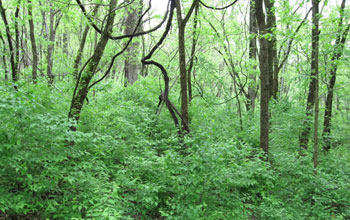
Amur honeysuckle at Cliff Cave County Park in Missouri: The plant has invaded wide swaths.
Credit: Kristin Powell
Download the high-resolution JPG version of the image. (533 KB
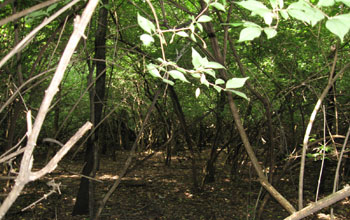
Amur honeysuckle twines through Cliff Cave County Park.
Credit: Kristin Powell
Download the high-resolution JPG version of the image. (852 KB)
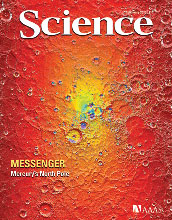
The researchers' findings are described in the January 18, 2013, issue of the journal Science.
Credit: Copyright AAAS 2013
Download the high-resolution JPG version of the image. (81 KB)
In Missouri forests, dense thickets of invasive honeysuckle decrease
the light available to other plants, hog the attention of pollinators
and offer nutrient-stingy berries to migrating birds.
They also release toxins that decrease the germination of nearby native plants.
Why,
then, do studies of invasive species come to different conclusions
about their effects and lead some organizations to suggest we accept
their presence?
Biologists Kristin Powell, Tiffany Knight and Jon Chase of Washington University in St. Louis have found an answer.
Most
studies of the effects of invasive plants are done at a single scale,
report the scientists in this week's issue of the journal Science. Some studies scrutinize biodiversity in meter-square quadrats, while others scan biodiversity in entire islands or regions.
Meanwhile,
invasives decrease biodiversity at small--but not at large--scales, the
researchers discovered, leading them to conclude that how invasive
species research is conducted can produce conflicting results.
"Perhaps
not surprisingly, the big picture perspective is fundamentally
different than the small-scale perspective," says Doug Levey, program
director in the National Science Foundation's (NSF) Division of
Environmental Biology, which funded the research.
Probing for scale dependence
The biologists had long suspected that studies of invasive species came to different conclusions because of scale dependence.
To
test this notion, they analyzed 57 previous studies and confirmed a
pattern: Invasive plants cause a large loss in species richness at small
scales, but this effect diminishes at larger scales.
To test for
scale dependence in the field, they chose three study sites in
different ecosystems across the United States, each straddling an
invasion front: a hammock forest in central Florida; an oak-hickory
forest in eastern Missouri; and a tropical forest on the Big Island of
Hawaii.
The hammock forest, a mix of live oak, cabbage palm, sweet gum and pignut hickory, is being invaded by the flax lily (Dianella ensifolia). Native to Africa and Asia, the lily forms dense mats on the forest floor.
Amur honeysuckle (Lonicera maackii),
a mid-story shrub introduced from East Asia as an ornamental to provide
bird habitat, is the issue in the oak-hickory forests.
The fire tree (Morella faya),
a canopy tree that boosts nitrogen levels in the soil, making it
inhospitable to native species and more suitable for invasives, is the
troublemaker in the Hawaiian forest.
Invasives don't just sweep the board
"We
counted the number of species per unit area in plots that varied in
size from one meter square to 500 meters square--a quarter the size of a
football field--on either side of the invasion front and then plotted
the number of species against the size of the plot," Powell says.
"At
small scales, invaded plots had many fewer species than uninvaded
plots, but they picked up species more rapidly. At broad scales the
invasives' effect on diversity virtually disappeared."
The reason for this "scale effect" is probability, says Powell.
"Invasives reduce the number of individual plants in a plot, and if there are fewer plants, there are fewer species," she says.
The invaded sites can catch up with uninvaded ones, Knight says, because the number of species does not increase indefinitely.
"At any site, if you sample larger and larger areas, the number of species will eventually plateau," Knight says.
At an invaded site, she says, "you reach that plateau later, but you do reach it eventually."
What it means for gardeners
The
research helps to explain seemingly contradictory findings in the
scientific literature, but what does it mean for people who've been
hacking down honeysuckle in their backyards, and brushing their boots
before entering conservation areas to avoid bringing in invasives?
Is it worth it or not?
"Emphatically yes," Knight says.
"Invasive species are a serious threat. If we're going to deal with them, we need the cooperation of the public."
Invasive
plants have negative effects on plant communities at smaller
scales--the scales that are crucial for ecosystem services like water
management and nutrient cycling.
Take the bush honeysuckle choking Missouri's natural areas, for example.
It
was seeded by birds carrying honeysuckle berries from backyards. To
prevent it from turning nature preserves into shrub monocultures, people
must remove it from their yards or choose not to plant it in the first
place.
While the small scale justifies the fight, the large scale offers hope.
"Invasive
plant species are reducing the abundance of native plant species, but
most species are still present when we search for them at broad scales,"
says Knight.
"They haven't gone extinct yet."
Which means
that it's not too late to restore habitat and increase abundances of
native species, says Knight, "so they can contribute to critical
ecosystem services and are less vulnerable to extinction."
-NSF-
Media Contacts
Cheryl Dybas, NSF (703) 292-7734 cdybas@nsf.gov
Diana Lutz, Washington University in St. Louis (314) 935-5272 dlutz@wustl.edu
Diana Lutz, Washington University in St. Louis (314) 935-5272 dlutz@wustl.edu
The National Science Foundation (NSF) is an independent federal
agency that supports fundamental research and education across all
fields of science and engineering. In fiscal year (FY) 2012, its budget
is $7.0 billion. NSF funds reach all 50 states through grants to nearly
2,000 colleges, universities and other institutions. Each year, NSF
receives over 50,000 competitive requests for funding, and makes about
11,000 new funding awards. NSF also awards nearly $420 million in
professional and service contracts yearly.
Useful NSF Web Sites:
NSF Home Page: http://www.nsf.gov
NSF News: http://www.nsf.gov/news/
For the News Media: http://www.nsf.gov/news/newsroom.jsp
Science and Engineering Statistics: http://www.nsf.gov/statistics/
Awards Searches: http://www.nsf.gov/awardsearch/
The National Science Foundation (NSF).NSF Home Page: http://www.nsf.gov
NSF News: http://www.nsf.gov/news/
For the News Media: http://www.nsf.gov/news/newsroom.jsp
Science and Engineering Statistics: http://www.nsf.gov/statistics/
Awards Searches: http://www.nsf.gov/awardsearch/
Guillermo Gonzalo Sánchez Achutegui
ayabaca@gmail.com
ayabaca@hotmail.com
ayabaca@yahoo.com
Inscríbete en el Foro del blog y participa : A Vuelo De Un Quinde - El Foro!

No hay comentarios:
Publicar un comentario